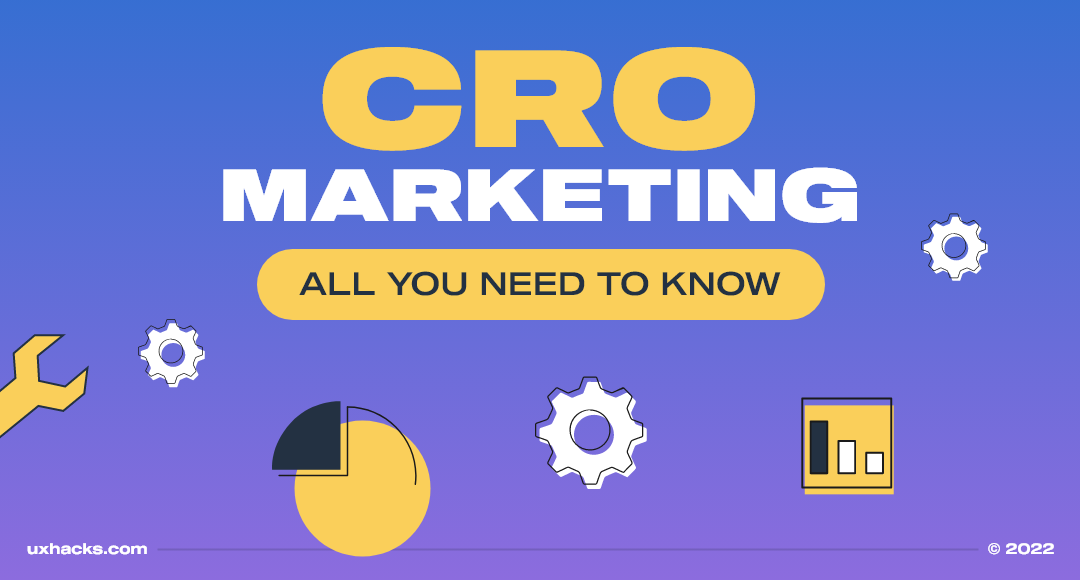What is CRO Marketing?
“Conversion Rate Optimization Marketing (a.k.a Conversion Marketing) is a digital marketing strategy focused on increasing the rate of conversion of website visitors to loyal repeat customers. As such, CRO is the ultimate goal of digital marketing, and of any successful business website.”
It’s all over the internet, you simply can’t get it out of your mind. It’s a strategy…it’s a process…it’s an acronym: but what does CRO Marketing really mean for you, your website and your business?
Table of Contents
What Is ‘Conversion’ in Online Marketing?
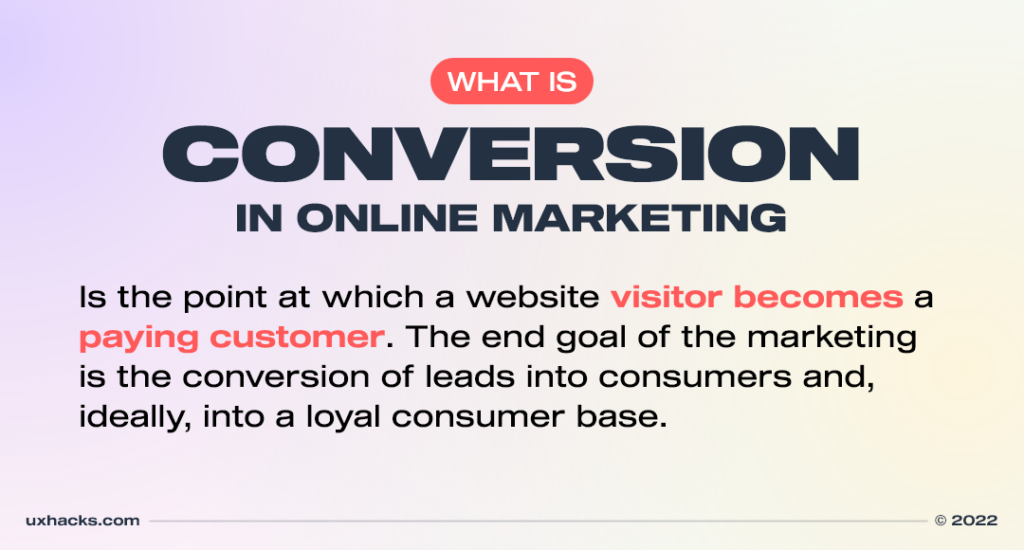
To understand CRO Marketing, you must first understand website conversion.
What is ‘conversion’ in digital marketing?
“In online marketing, ‘conversion’ is the point at which a website visitor becomes a paying customer. It’s the end goal of not only online marketing but of all marketing for business – the conversion of leads into consumers and, ideally, into a loyal consumer base.”
You might offer a stellar range of products or services, but without a strategy in place that converts people to buying customers, you could end up with a constant steam of interested visitors, but very few paying clients.
The ultimate conversion for any business – whether you offer a product, a service or a blend of both – is undoubtedly the sales transaction. Sales aren’t the only type of conversion, however, particularly when it comes to digital marketing.
The transaction of sale may well come further down the marketing funnel, with other key conversions taking place along the way: e.g, think social media likes, YouTube views, mailing list subs, LinkedIn follows, etc.
It’s time to break down the process and strategy for converting website visitors to customers, as well as how to use formulas and website design for intelligent conversion rate optimization.
What Is Conversion Rate?
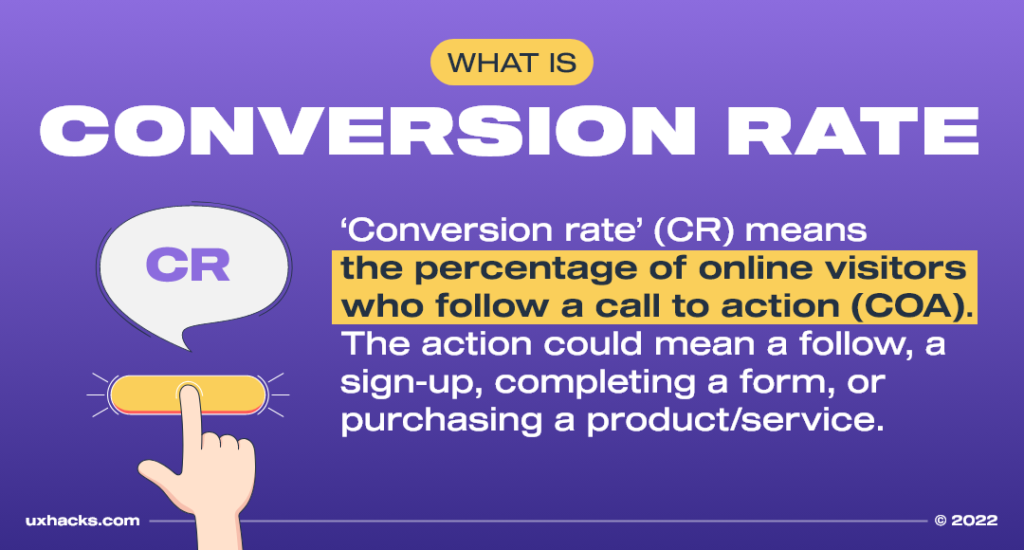
We’ve established what ‘conversion’ is in terms of digital marketing: it’s about having a visitor or qualified lead complete the desired action that has been defined in the marketing strategy.
What is Conversion Rate? How do you boost Conversion Rate?
“In online marketing, ‘conversion rate’ (CR) means the percentage of online visitors who follow a call to action (COA). The action could mean a follow, a sign-up, completing a form, or purchasing a product/service. CR is boosted by quality SEO copy, relevant product, and COAs!”
When the conversion rate is high, the website marketing strategy is successful. This is the benefit of a website that’s formatted and designed effectively, with compelling copy, COAs (Calls to Action), and a service/product that speaks to your target audience.
A low conversion rate, on the other hand, could indicate poor website performance, SEO neglect, lacklustre content, buggy design, inadequate sales funnelling, invasive PPC ads, and more.
This guide will detail the hallmarks of a good and bad conversion rate, how to calculate your CR, and how to optimize CR to reach your business goals.
What’s the Difference Between CRO and SEO?
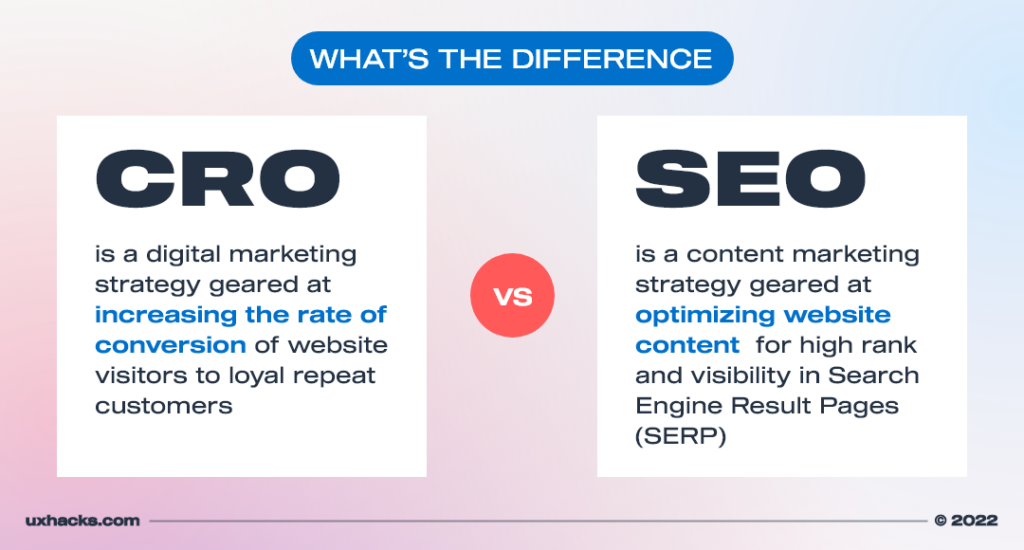
What is the difference between CRO and SEO in online marketing?
“Conversion Rate Optimization(CRO) is a digital marketing strategy geared at increasing the rate of conversion of website visitors to loyal repeat customers; whereas Search Engine Optimization (SEO) is a content marketing strategy geared at optimizing website content for high rank and visibility in Search Engine Result Pages (SERP).”
CRO and SEO, people often confuse the two terms, but they are both essential, symbiotic elements of any intelligent online marketing strategy. Now, let’s delve deeper.
How to Align Your CRO and SEO Strategies
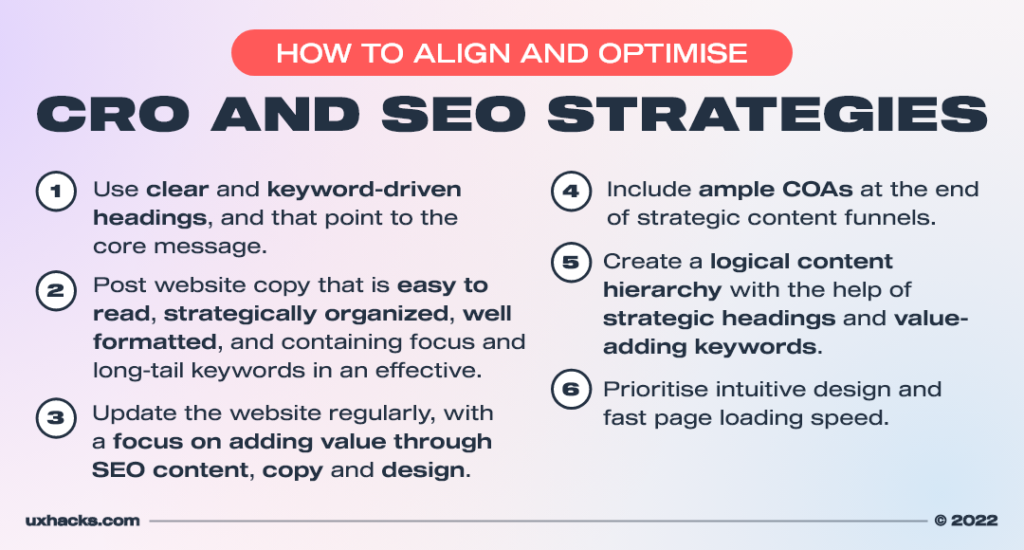
Search Engine Optimization is all about the techniques you can use online to increase the exposure of your business’s website in search engine results or SERPs. There is both on-page SEO and off-page SEO.
What is the difference between on-page SEO and off-page SEO?
“On-page SEO uses keyword research to create site content (web copy and images) in alignment with words and phrases that people are actually searching for. Off-page SEO centres around the site coding and link building that best aligns with the algorithmic parameters of the search engine AI.”
To align and optimize your CRO and SEO strategies, focus on the following:
- Include headings that are clear and keyword-driven, and that point to the core message and purpose of each page.
- Post website copy that is easy to read, strategically organized, well formatted, and containing focus and long-tail keywords in an effective (but not overwhelming or nonsensical) way.
- Ensure regular updates to the website, with a focus on adding value through SEO content, copy and design.
- Include ample (but not excessive) calls to action at the end of strategic content funnels.
- Create a logical content hierarchy that streamlines the user experience with the help of strategic headings and value-adding keywords.
- Prioritize intuitive design and fast page loading speed, as 40% of website visitors will wait no longer than 3 seconds for a page to load.
Basically, it’s vital to keep both SEO and CRO in mind. A prerequisite to be mindful of, however: never sacrifice the quality of the content simply to boost SEO. So, avoid keyword bombardment, excessive calls to action and anything that detriments user experience. Now, let’s delve even deeper into CRO Marketing.
What Is CRO Marketing?
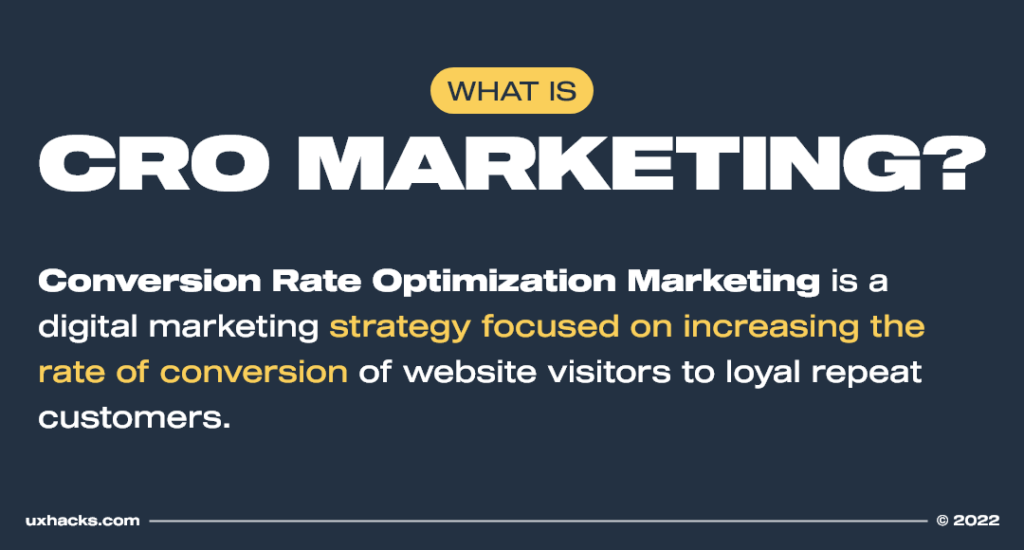
“Conversion Rate Optimization Marketing (CRO Marketing) is the strategic planning of website content and calls to action, so as to guide (or funnel) your visitors through the customer journey from first-time visitor to repeat customer.”
You create this conversion funnel through the functionality, content and design of your website and, as we indicated before, you must highlight clear conversion goals for your business, like driving subscription to your mailing list, gaining follows, boosting product purchases, etc.
Optimization is always a good thing.
For example:
You can optimize the way that you work by using digital tools and tricks that see you spending less time online but getting higher output. It’s all about having an efficient system in place that enhances the chance of success as much as possible.
With an inspired marketing strategy, even ‘chance’ no longer comes into play. Your online presence and business website becomes a well-oiled machine that converts site visitors through an intelligent but considerate customer journey. That’s what you’re aiming for.
So, when it comes to CRO Marketing, you want your efforts to boost conversion rate as well as drive repeat sales. Your plan is based on the needs and goals of your company as well as the needs of your target market, and it will include multiple defined steps that are both actionable and testable.
When you’re able to analyze the traffic of your site and your conversion rates, you empower yourself with the information you need to boost scores and build up a loyal customer base. With this data in hand, you can start to employ the relevant tactics to reach your conversion goals.
Key website visitor conversion goals include (but are not limited to):
- gaining subscribers that receive marketing material and newsletters via an email mailing list
- gaining customer data, feedback and leads when visitors input personal information into a form or take a user survey
- increasing the time spent by visitors on your website or on certain site pages
- increasing free content downloads
- increasing membership sign-ups, sales and service upgrades with a strategic conversion funnel
- driving sales, bearing in mind that all other goals should act as stepping stones to some kind of of purchase or exchange, in line with the profit goals of your business.
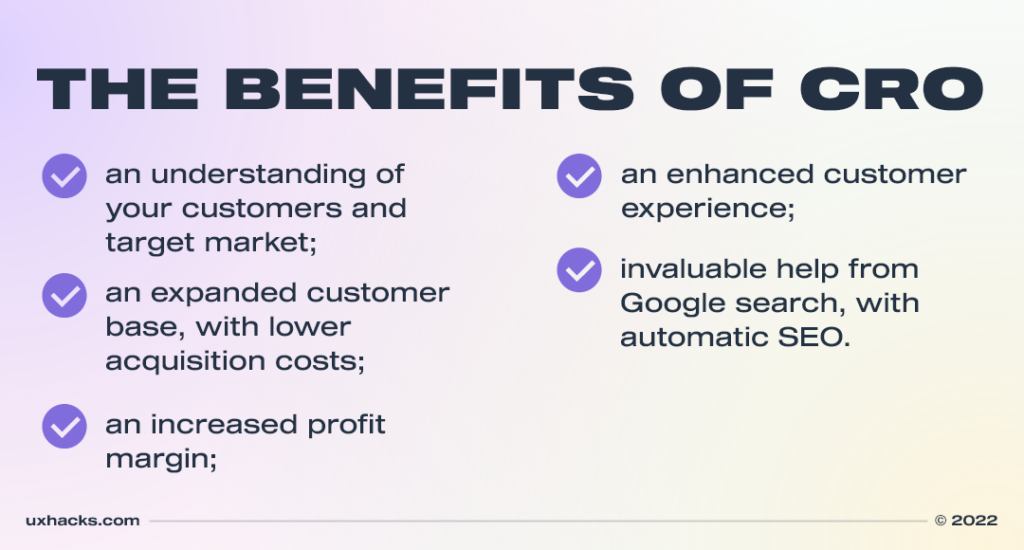
What Are the Benefits of CRO?
For any business that relies on digital marketing for all or part of its income, CRO is vital. The following benefits await those who put time, effort, and resources into quality CRO.
The benefits of CRO include:
- an understanding of your customers and target market
- an enhanced customer experience
- an expanded customer base, with lower acquisition costs
- an increased profit margin
- invaluable help from Google search, with automatic SEO.
Again, let’s dive deeper.
An understanding of your customers and target market
The strategies that you create for CRO are based on understanding what your customers need and want, and how they might best be guided to get these things from you.
The data points derived from expert CRO testing (to be covered later) will offer in-depth insight into your visitors’ preferences and behaviors. With these details as leverage, it becomes that much easier to capture visitors as customers through your written SEO copy, imagery, opt-in free products, and more.
An enhanced customer experience
A high conversion rate tells you something important – customers are engaging with your brand. They wouldn’t convert if they didn’t see value in the experience or enjoy doing so, which means that they are happy with the time they spend engaging with your site and contents.
With a better customer experience, clients are far more likely to return and stay on as loyal fans of your company. Even tiny adjustments like a clearer font to read or brighter CTA buttons can do wonders for enhancing the customer experience, and therefore, the visitor CR.
An expanded customer base, with lower acquisition costs
You want to bring in more customers. More returning customers equals more sales, which equals meeting business goals quicker and by a higher margin. CRO can help you to lower your cost of acquisition (bringing in new customers), because all it really takes is the optimization of the contents of your site to meet the customer’s needs and preferences.
If you’re spending a fortune on ads and a dedicated marketing team, but not really looking at the experience people have once they are directed to your page, it’s time you leverage SEO to save money. Once your SEO brings people in, you can ditch the pricey ads and focus on CRO to keep your new visitors engaged.
If your SEO is in already line, you can focus on capturing new customers from the number of visitors you already have (but who otherwise wouldn’t be purchasing), with the help of active CRO.
An increased profit margin
Of course, this is the holy grail for any business. If your conversion rate has been optimized and is continuing to rise, it means you’re doing something right in terms of digital business strategy.
It means that whatever desired actions people are taking, it’s helping you to meet your goal of higher profit margins: it’s capturing and converting people from visitors into paying customers!
Invaluable help from Google search, with automatic SEO
Yes! This is a great benefit. When Google sees that there’s more traffic and engagement with your site, you’ll automatically be bumped up in search engines. It’s like automatic SEO that’s inadvertently created through the simple maintenance of an engaging, streamlined website.
By now, you’ve likely realized that CRO is, well, important. But, what’s the first step? And, how do you analyze website traffic to get that proverbial client data? Before you can start to experiment with the best CRO strategies that will work for your audience, you’re going to need to assess your website: this is where CRO testing comes in.
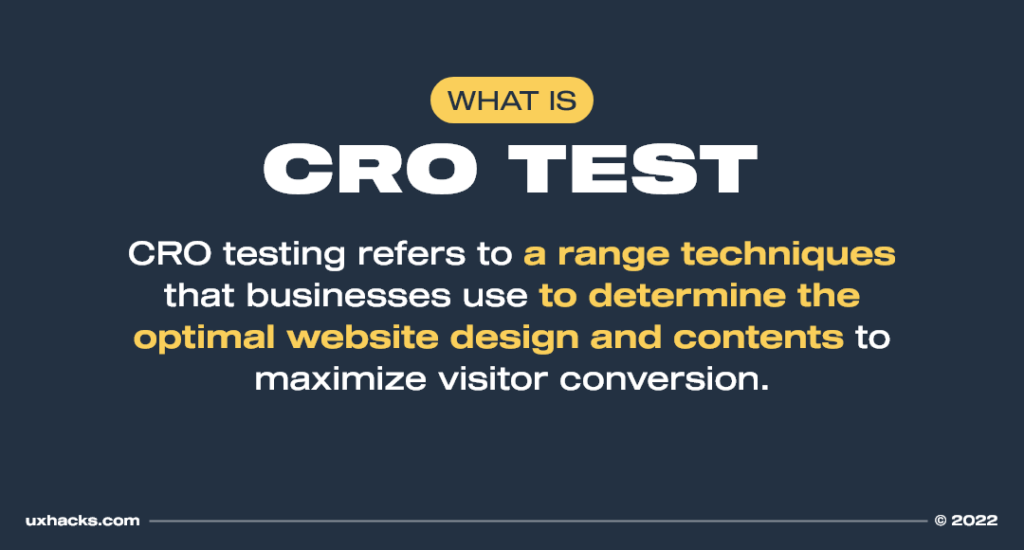
What Is a CRO Test?
“CRO testing refers to a range techniques that businesses use to determine the optimal website design and contents to maximize visitor conversion. A popular CRO testing technique is A/B testing (a.k.a. Split Testing), which compares website versions to find the version that’s closest to optimal CR.”
For the validity of the results, these tests need to be linked to quality data like user feedback, heat maps for websites, analytics tools, and more. Otherwise, a website owner will risk putting their own bias and perspectives into the mix, which could lead to less than ideal CR results.
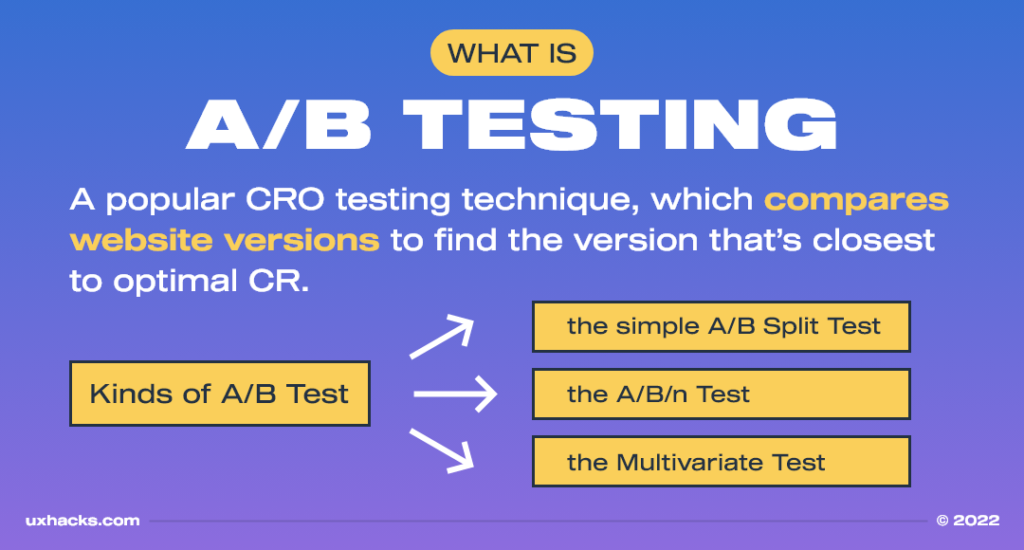
A/B Testing Explained
There are actually multiple testing methods that fall under the A/B umbrella, including:
- the simple A/B Split Test
- the A/B/n Test
- the Multivariate Test.
This type of testing is about creating a controlled environment where you can directly see the impact of different changes you make. Firstly, you’d create a hypothesis (potential/expected outcome) and use the testing as a way to prove or disprove it.
A ‘hypothesis’ is explained like this:
If (variable), then (result) because (rationale).
For example:
If (we make the CTA buttons larger and brighter), then (people will click on it more) because (they will see it more clearly and know that it is the next logical step).
Now, let’s take a closer look at those A/B Test variations.
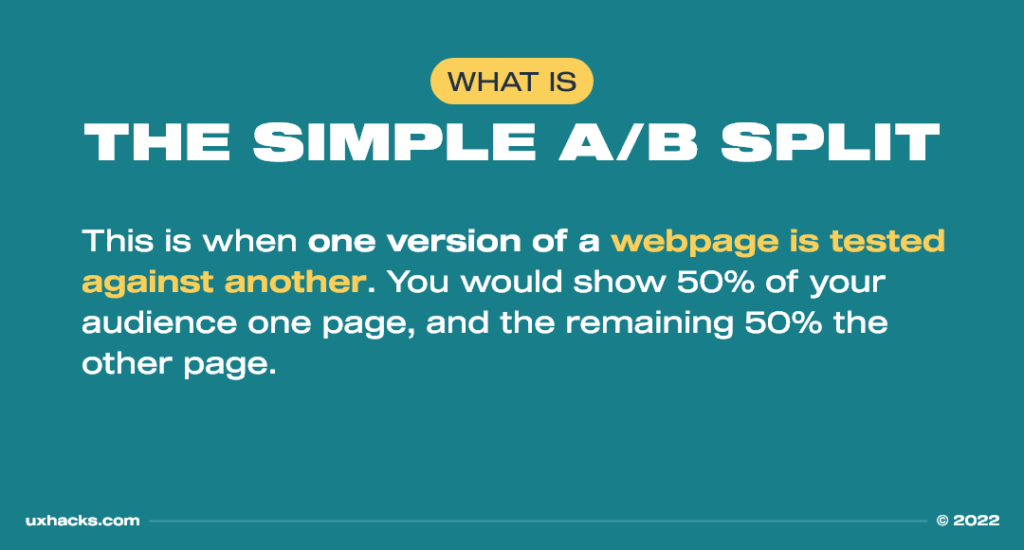
1. The Simple A/B Split Test
A/B testing is also referred to as split testing. This is when one version of a webpage is tested against another. You would show 50% of your audience one page, and the remaining 50% the other page.
For example:
You’re testing the impact of changing the style of the button and the words in the CTA on a product page. The hypothesis might be that the larger and brighter button will generate clicks. In the A/B test, you’d trial run two versions of the same page, each containing a distinctly styled and worded CTA.
You’d work out a visitor sample size to run the test. This is based on how many page visitors and how many conversions the page is already receiving. If the page doesn’t have many (or any) visitors or conversions, it’ll take a long time to get a big enough sample to come to any significant conclusions.
Valid results will come from pages that have good traffic and a decent number of conversions. Research indicates a required minimum of 5 000 unique visitors per page variation, along with at least 100 conversions.
So, if traffic is usually 10,000 people on the landing page and conversions are 1,000 people a month, then for the split test, your sample size might be 5000 people to each version of the landing page with 500 people converting on the original version, and more or less than 500 people converting on the new version (depending on it’s success).
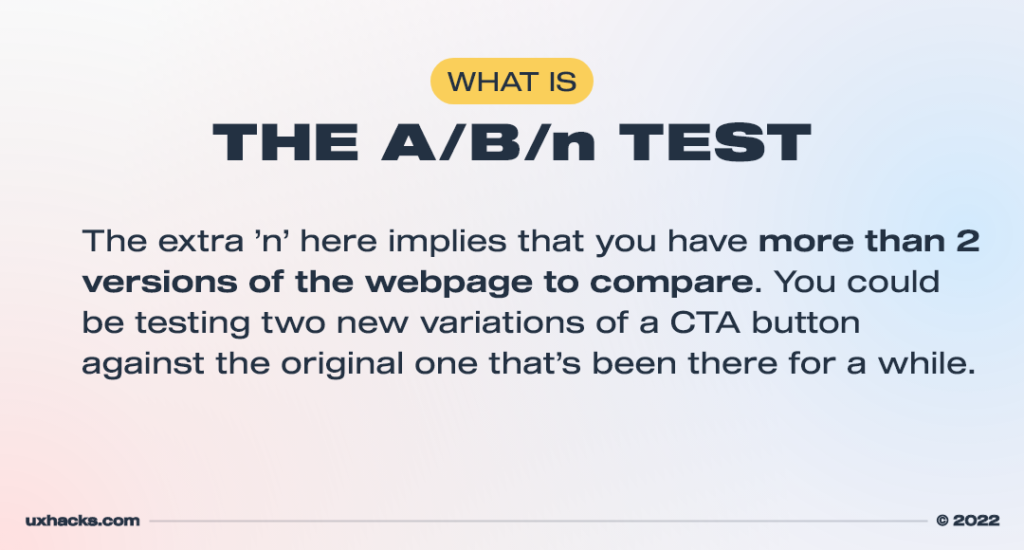
2. The A/B/n Test
The extra ’n’ here implies that you have more than 2 versions of the webpage to compare. You could be testing two new variations of a CTA button against the original one that’s been there for a while.
Since you’re testing three or more versions, you’d split your audience into three or more groups. This creates a smaller sample size than the simple A/B test so, A/B/n tests will take a longer time to gather enough data for assessing the results.
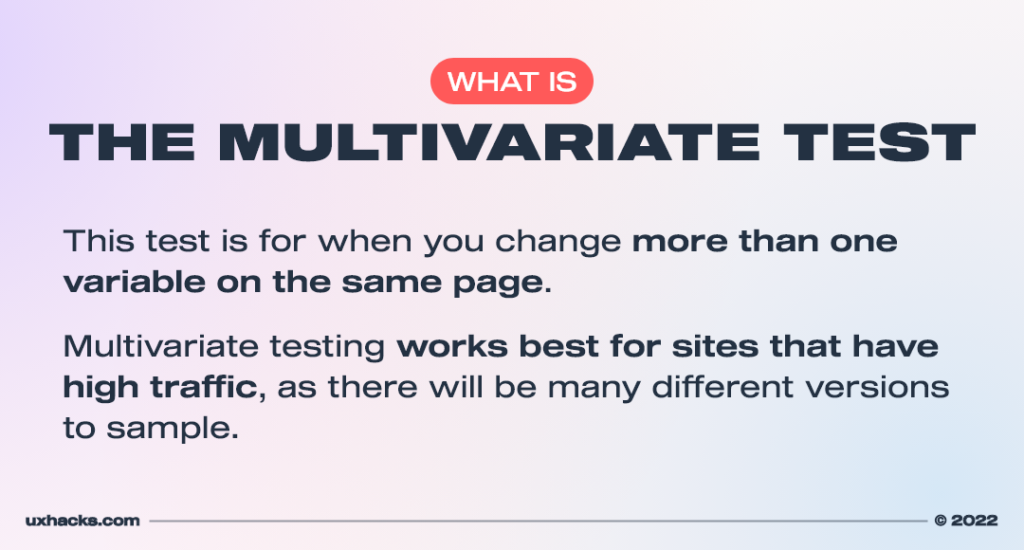
3. The Multivariate Test
This test is for when you change more than one variable on the same page. So, rather than just a different button style, you might also test different sales copies, images, and more. These tests are used to see which combinations of variables are preferred by your audience.
Multivariate testing works best for sites that have high traffic, as there will be many different versions to sample.
For example:
You might test three variations of the CTA button (CTA1, CTA2, and CTA3), as well as three versions of the website copy (C1, C2, and C3). This means that there are, in total, 16 combinations to test, including CTA1/C1, CTA2/C1, CTA3/C1; CTA1/C2, CTA2/C2, CTA3/C2, etc.
Based on the minimum unique visitor and conversion requirements, you’d need to have a very busy site to get valid results!
Which testing goals should you focus on?
Depending on your conversion goals (based on your market strategy which, in turn, is based on your business goals), your testing goals will vary. Most CRO testing is geared towards sales and other transactions, but you could also create goals like how many people make it to the basket or check out.
Micro-goals can also be tested, like how may people search, interact with or click certain aspects of navigation (e.g. swiping through the gallery of product pictures).
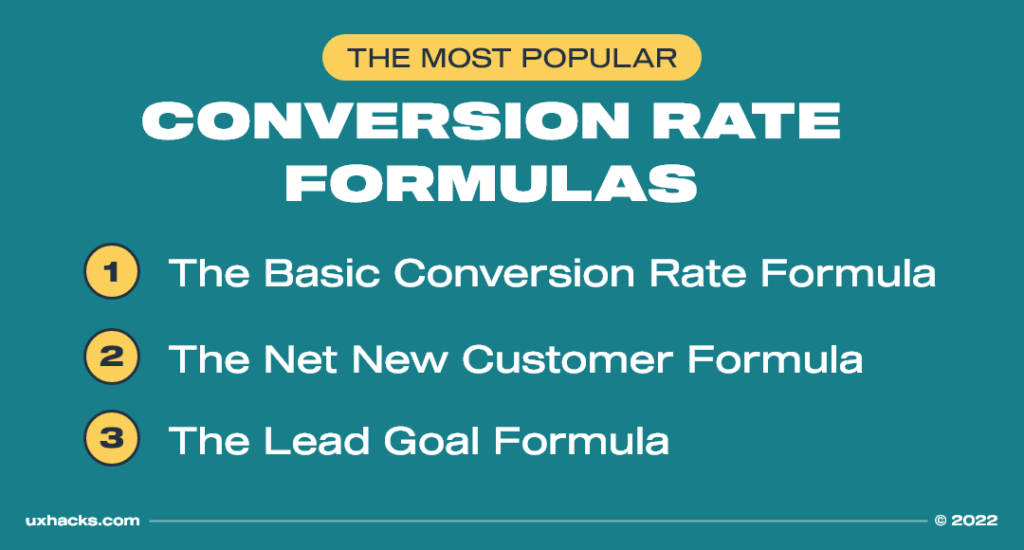
How to Calculate Conversion Rate: Conversion Rate Optimization Formulas
How do you calculate website conversion rates?
“Visitor conversion rate (CR) can be calculated (manually or with analytics tools) for set variables (e.g. during A/B testing), or for a website as a whole. The total number of conversion opportunities (e.g. clicking a button, making a sale, signing up, etc.) is divided by the total number of site visitors.”
Calculating your conversion rate is simple when you know how you will define conversion. You’ll need to know the number of conversions and the number of visitors, and then simply multiply it by 100 to get a percentage.
For example:
If you want to calculate the conversion rate of your free ebook offer, you would divide the number of people that downloaded the ebook by the number of people who visited the landing page where the offer is listed.
A standard formula for calculating website conversion is:
CR = C/V x 100
So, Conversion Rate = Number of Conversions divided by Number of Visitors, multiplied by 100 to find percentage.
This calculation will only be done when you have reached the required sample size and the required run time for your CRO test.
How do you calculate the monthly conversion rate for a website?
“To determine your website’s overall conversion rate by month, you’d find the number of visitors and conversions for a given month, then calculate using the CR formula: Monthly Conversion Rate = Number of Conversions divided by Number of Visitors, multiplied by 100 to find percentage.”
For Example:
September website analytics:
Website Visitors: 2,000
Total Number of Conversions: 500
The monthly conversion rate here would be 50% (500 divided by 2,000 multiplied by 100 = 25%).
Cross-examining two months and looking at the changes that were made on the website, as well as the part played by external factors (like holidays and pay-day), is a good place to start when defining CRO strategies, or when planning further tests.
With CRO, you’re looking to get more quality conversions out of your existing website traffic. Setting a conversion goal isn’t as basic as just saying, “we had 50 conversions last month, so let’s convert 100 people this month.” It’s not just about doubling up the number of conversions from your site.
Instead, you’re looking to up the conversions for a set number of people who visit (e.g. 50 more conversions for every 200 people who visit). That’s why we have the conversion rate formulas: to work out the percentage of converts, not just the number that you see in your analytics.
The three most popular conversion rate formulas used by businesses during CRO include:
1. The Basic Conversion Rate Formula
2. The Net New Customer Formula
3. The Lead Goal Formula
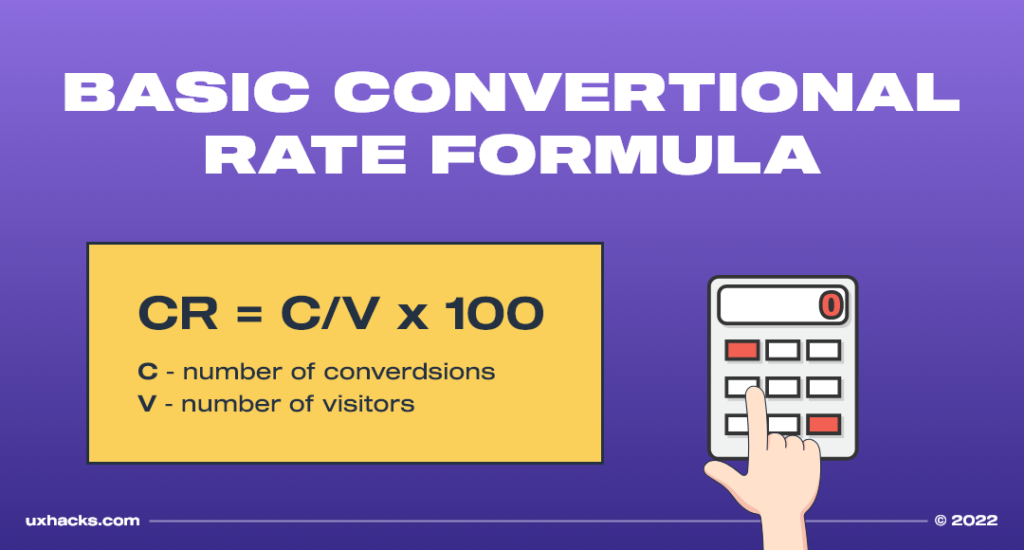
1. The Basic Conversion Rate Formula
This was the example formula outlined above. You get this percentage by dividing the number of conversions/leads by the number of visitors, then multiplying it by 100 for percentage.
Conversion Number divided by Number of Visitors multiplied by 100 = Basic Conversion Rate
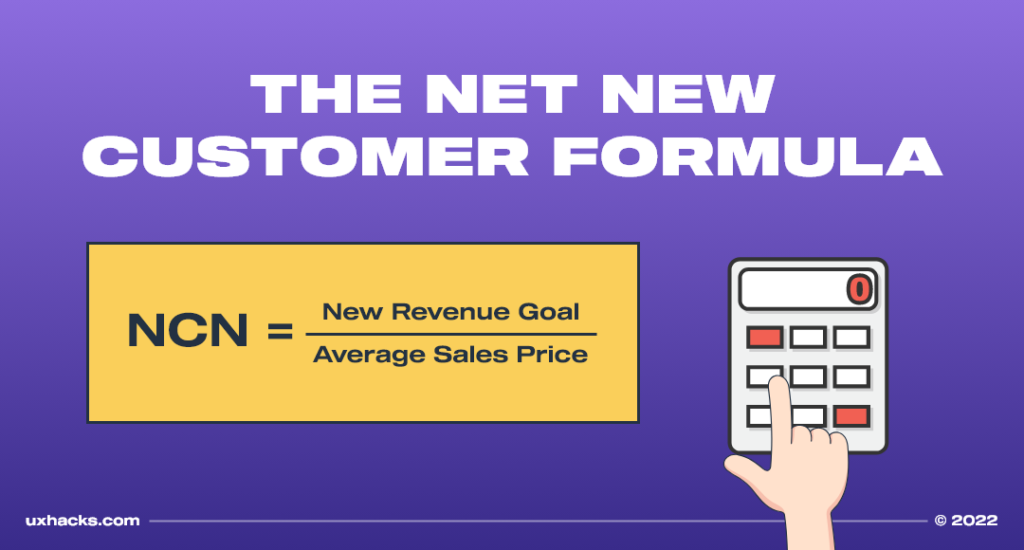
2. The Net New Customer Formula
This is where you would divide your net revenue goal by the average price of your sales. This shows you the number of new customers, enabling you to define goals for how many new customers you need in order to to meet a certain revenue goal.
For example:
If you have a revenue goal of $500 and your average sales price is $15, you will need 20 new customers coming in in order to reach the goal.
New Revenue Goal divided by Average Sales Price = New Customer Number
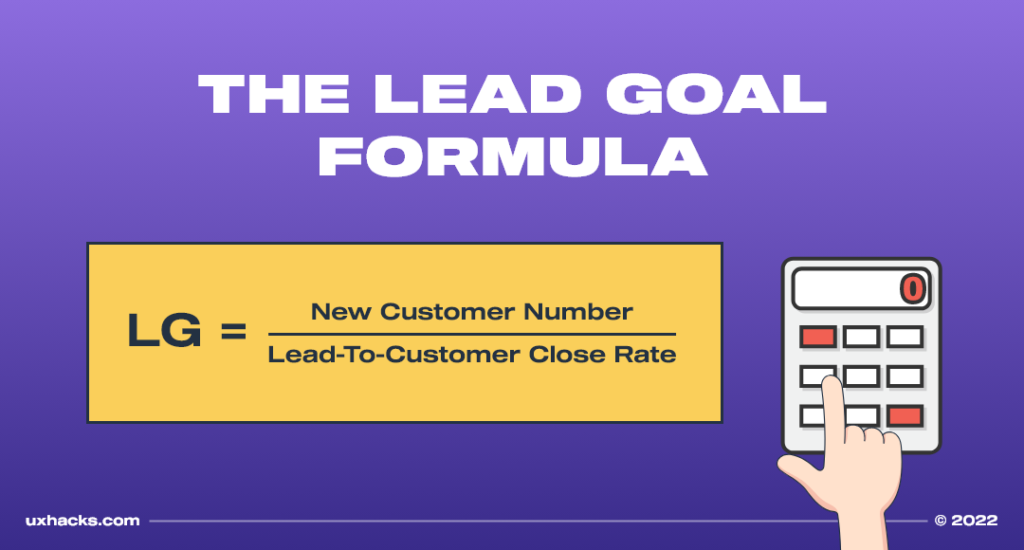
3. The Lead Goal Formula
This number is about how many leads you want to attract. To do this, you would divide your number of new customers by your lead-to-customer close rate percentage (which is the total number of leads divided by total number of customers).
New Customer Number divided by Lead-To-Customer Close Rate Percentage = Lead Goal
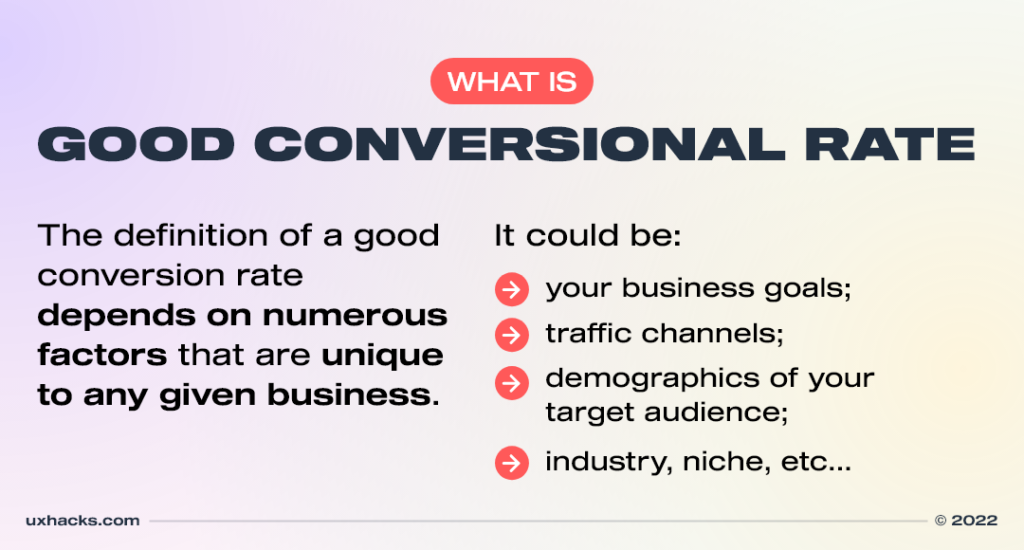
What Is a Good Conversation Rate?
“The definition of a good conversion rate depends on numerous factors that are unique to any given business. Your business goals, traffic channels, demographics of your target audience, industry, niche, and more will all play into what you consider as a good website conversion rate within CRO strategy.”
The average conversion rate for e-commerce businesses as of November 2021 was 2.24%. That has actually gone down 0.02% from 2020. However, both January 2021 and 2022 had the same conversion rates across e-commerce businesses at 1.74% (much lower than 2020 and 2021 November rates).
Notice the impact of the time of year on conversion rates across all industries during Thanksgiving and Christmas holiday shopping surges (November). You can compare this to after the holidays, when spending goes down (January) to understand that conversion rates aren’t just impacted by the actions you take with marketing, but also by a range of external factors.
Your goal isn’t to be in the average or to be following this trend of downward conversions. You want to have above-average rates that steadily rise year over year: you’re aiming for success!
Ideally, you should look at the average conversion rates in your industry or niche (and for the time of year, if the data is available) to assess where you stand. If you see that the rate is lower than average or than your top competitors, or lower than your set goals, then you need to double down on CRO. Here’s how to do it…
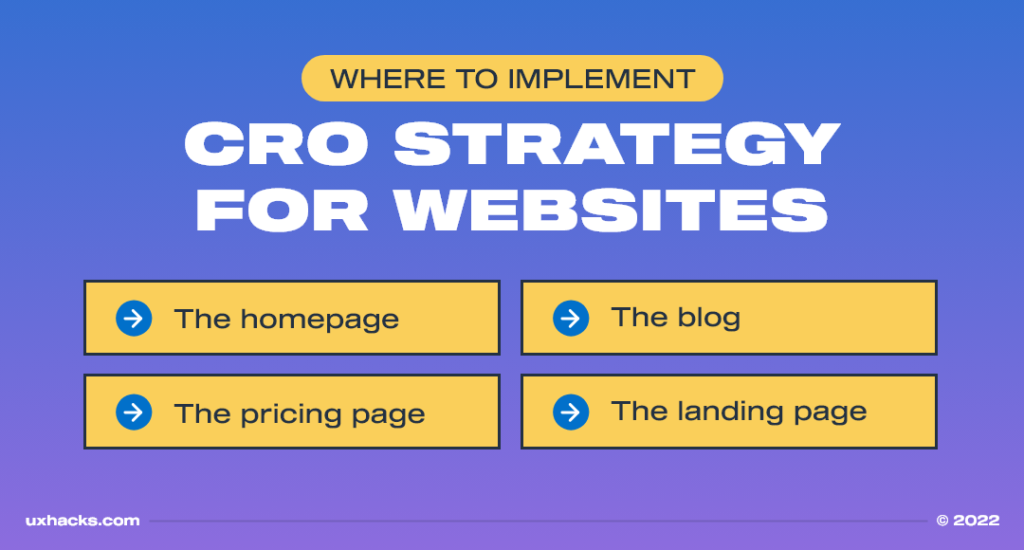
Where to Implement CRO Strategy for Websites
The four key areas of your website that will offer you the most potential benefits from intelligent CRO include:
The homepage
This is where you make the very first impression on your site visitors, so optimizing your home page for better conversions is essential. You’re guiding them through the customer journey with the homepage as the first step through the door.
Leveraging your homepage to keep your site visitors on your site longer is ideal. Implement homepage CRO by creating clear links to product pages, offering a free sign up to your mailing list with strategic pop-ups, and including at least one clear and compelling call to action.
The pricing page
The design and functionality of the pricing page are essential for converting visitors into paying customers. They made it this far already – being directed to the prices of your products, services, or membership – so how you display the information can make or break the online customer conversion process at this point.
One way that companies do this (e.g. when selling service/product plans) is by showing different prices per year and per month, allowing the contrast to visually highlight the savings that customers can make.
Be mindful of the way your price-tier features are described, the format and placement of your buttons to purchase, links to talk to a representative about the pricing models, phone number, contact details and more. All of these are essential CRO considerations.
The blog
A website’s blog is a great way to not only boost a website’s SEO (with on-page keyword optimization), but it’s also a key tool to convert visitors to leads or customers. Blog readers are qualified leads, as they are there to learn and are investing time to actually read the content – which reveals their interest in the product/service.
A quality, original blog is how you create interest, added value and impetus for potential clients. Including CTAs throughout the article, downloadable guides with extra information, and ending the blog post with an offer or link to a product page are all important CRO tactics.
The landing page
The core intent of a landing page is to invite people to take an action. A landing page could also be called a call to action page. The conversion rates of landing pages are higher than most of the pages of a site, with the average landing page CR being 4.02% in one major study of 10 different industries.
Many marketing campaigns will utilize stand-alone landing pages, rather than directing people just to a sales page or a homepage. Popular landing page optimization actions include adding videos and testimonials about the product/service. Additionally, creating urgency with time-sensitive offers and displaying a count-down timer can also be key conversion optimization tactics.
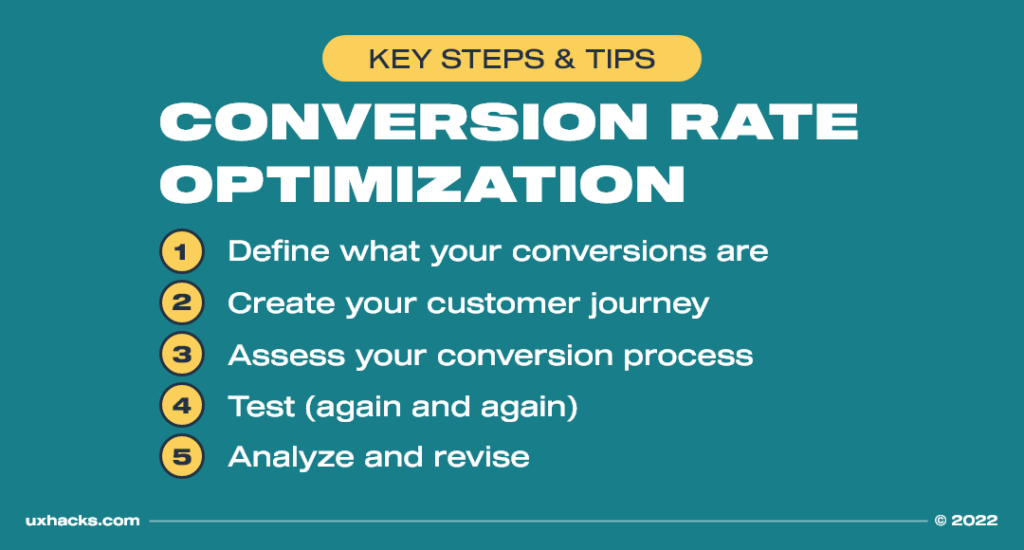
Conversion Rate Optimization Key Steps & Tips
When you’re beginning to focus your time on CRO, start with the following steps and be sure to implement the tips we share below.
The key steps to website Conversion Rate Optimization include:
- Step 1: Define what your conversions are.
- Step 2: Create your customer journey.
- Step 3: Assess your conversion process.
- Step 4: Test (again and again).
- Step 5: Analyze and revise.
Step One: Define what your conversions are
The first step for CRO is to define what your conversions actually are – what specific action do you want your visitors to take? do you count conversion as the click-through to any page or certain pages? Is conversion signing up for the email list, downloading a free guide, purchasing a product, or all of the above?
The action that you want your visitors to take will depend on the goal of your marketing campaign. Without a clear metric, that conversion data won’t have any meaning. These metrics are called Key Performance Indicators (KPIs). These are a blueprint of what you see as optimum. You’ll further define your KPIs with the research you do for step two below.
Step Two: Create your customer journey
When you look deeper into who your customers are and where they are coming from, you can start to define an intelligent customer journey based on real data (rather than assumptions). Collect this data from your website analytics and other research (surveys can also be created and incorporated at this stage).
You’ll want to focus on demographics, geography, occupations, interests, behaviors, traffic source (where they came from), and more. Often, businesses will create an avatar of their customers, outlining a persona that can help define target customers in a more tangible way.
With this information in hand, you can further categorize customers into segments and sub-segments for a very specific customer profile outline. A tip here is to rank the segments based on how likely you feel they are to convert, and target those most valuable or likely customers first.
Step Three: Assess your conversion process
There is a wealth of information hidden in the conversion process that you might be neglecting, and examining how your site is performing is key to exploiting it. Once you look at the numbers, start by asking the following key questions.
To assess your website conversion process, ask:
- Is the web copy difficult to read (large enough, clear fonts, etc)?
- Are my web pages loading too slowly?
- Are there enough (or any) testimonials/reviews/social proofs on the site?
- Is the CTA visible and compelling?
- Are there too many distractions (like intrusive or tacky PPC ads and pop-ups?)
Find the pages with the lowest ratio of traffic to conversions (high traffic but low conversion rate): these are the pages with the highest potential for optimizing conversions!
Step Four: Test (again and again)
Now is the time to experiment, it’s a key step in the CRO process (if you skipped to this part of the article – click here to read about testing).
You want to test a range of design and functionality variations of your site against the original version, to see whether the change is optimizing (raising) the conversion rate or lowering it. You’ll likely do multiple tests for the site (and it’s advantageous to do this regularly as well) as the content, the market and your business will all evolve over time.
Step Five: Analyze and revise
The most important part of the testing in the conversion optimization process is to see whether your hypothesis was correct. Remember your Key Performance Indicators – the metrics you’re focusing on – and your overall goals when you analyze the results of your tests. Not every test will yield good results – but that’s actually good information!
So, a test that gives a lower conversion rate isn’t necessarily a bad one, because it still gives you actionable data. A bad test is one where the testing methodology isn’t correct (you’re not actually testing properly). Once you revise the results and see what does and doesn’t work, get even more granular and test again.
The rinse and repeat process of CRO is intrinsic to getting the most out of your optimization efforts. Revising could take you back to step three, or you could even go back to defining what your customer segments are, the point is … rinse and repeat.
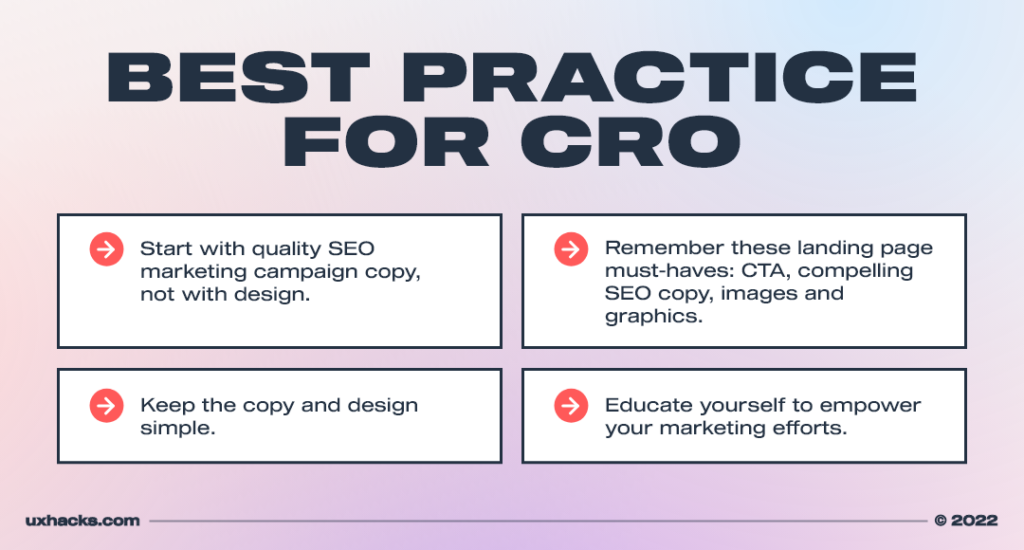
Best Practices for CRO
Now for some key tips that can help to optimize your conversion rates. Again – it’s a very unique process for each business, depending on your industry, target market demographics, and goals, so take the tips as offerings.
The are proven ways that businesses have gained success (a higher conversion rate), and these can be used in your experimentation process as you start to engage in active CRO.
Best practices for online CRO include:
- Start with quality SEO marketing campaign copy, not with design.
- Keep the copy and design simple.
- Remember these landing page must-haves: CTA, compelling SEO copy, images and graphics.
- Educate yourself to empower your marketing efforts.
1. Start with quality SEO marketing campaign copy, not with design
The user experience is created through the design, but the core information that the user is looking for is expressed in the SEO copy. Your goal is an uplifting user experience, with customers gaining value from copy that they’re actually interested in. They are not there simply to look at a pleasant aesthetic, even though they will appreciate it.
So, one tip here is to not sacrifice web copy by putting design first. Ensure that content is engaging, interesting, informative, and directing people down the conversion funnel to the next step. Furthermore, use SEO keywords to rank, guide and build interest, but do so within the confines of good grammar and style.
A sub-tip in this best practice for great web copy quality is to mine user reviews to determine what you will speak to. This is such an easy and effective way to be sure that you are addressing people’s real problems, desires, and use-cases for the service/product that you’re providing.
2. Keep the copy and design simple
Some CRO newbies might think that they need to add extra features, copy, design elements, or more to their site to optimize it. Most of the time, it’s not about adding quantity at all, but rather about changing some elements, shifting the design of what is already there, or taking things out.
Clear, simple landing pages almost always perform better than complex, long pages that have people unsure of where to look and what to do. Complexity often equals distraction and frustration, whereas simplicity equals clarity and engagement.
So, for CRO, rather than adding, think more about switching or minimizing. If you think that your website or landing pages need a redesign, here’s an in-depth guide we wrote:
? How To Redesign A Website in 2022
3. Remember these landing page must-haves: CTA, compelling SEO copy, images and graphics
The elements of a landing page that generally perform well include a CTA (one or more, but not too many) of some kind, compelling copy (especially in the headings), imagery, or at least some form of color or graphics, and some social proof.
4. Educate yourself to empower your marketing efforts
Going in blind with your assumptions and the idea that through enough tests, you’ll eventually figure out what is happening and what people like will waste time, energy, and likely any money that your’e putting into your marketing efforts.
Instead, be sure that you’re using informative tools to understand how people are engaging on your site already. We shared this in step two of the previous section – collecting data.
Ultimately, when you examine your site visitors, consider what is driving traffic (by looking at where it’s coming from), and collate this with the data around how your visitors are navigating your site. Ensure that you’re making informed decisions!
At the very least, use Google Analytics to gather data and other helpful CRO tools like Hotjar or Qualaroo.
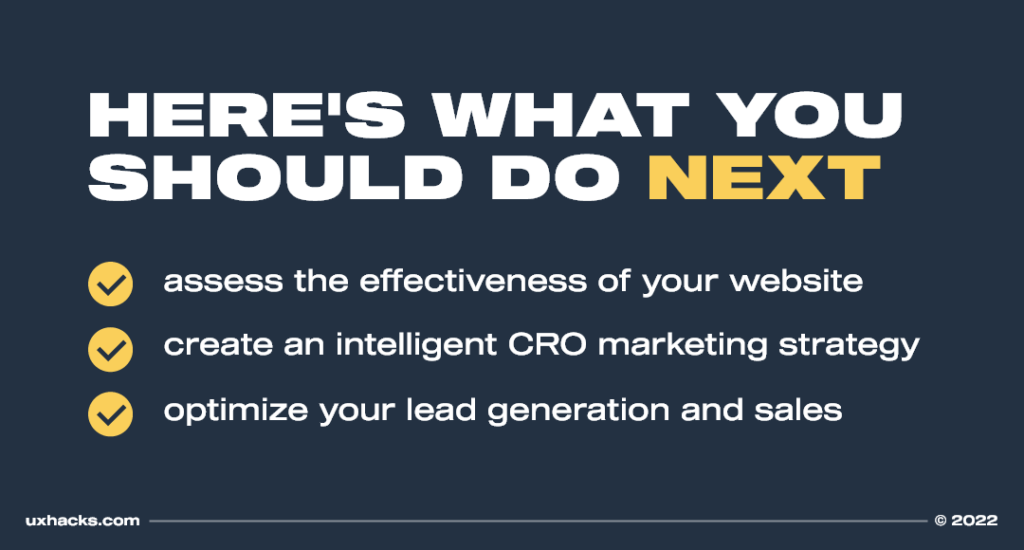
CRO : The Bottom Line for Hitting Your Business Goals
Optimizing your website to get higher rates of conversion (and hitting those business goals) is part science, part experience, and part skill. Gathering data and testing can take a lot of work but, if it’s something you know you can benefit from, reach out to us for some expert help.
Get help assessing the effectiveness of your website, create an intelligent CRO marketing strategy, and optimize your lead generation and sales, no matter what industry your business is operating in.
